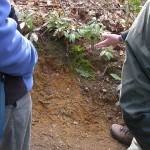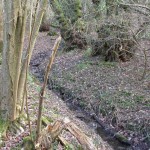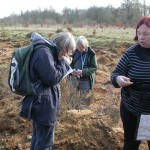Lesley Dunlop led a walk to look at the geology of The Coombes, near Barkham, on Saturday 25th February. The walk started at the top of the site, on river terrace gravels which had been laid down about 250,000 years ago. An exposed bank showed flint-origin gravel, with the pebbles in a mixture of shapes and sizes. 2 Goldcrests in a bush at the side of the track displayed their fiery orange caps and drumming woodpeckers were heard. The route then led down into the woods and onto the Bagshot Sands, which had been laid down in a marine environment 49 – 44 million years ago. The strong orange colouring of an exposed bank of sand indicated that it had a high iron content. There were occasional beds of flat rounded pebbles, which would have been laid down near a beach. Some creatures, perhaps bees, had excavated round holes in the sand. Bluebells, Honeysuckle and Wood Sage were growing in this part of the wood. As the path descended towards the bottom of the woods, the conditions became boggy and streams began to appear. This marked the start of the London Clay, laid down 56 – 49 million years. The ground flora became notably richer, with Wood-sorrel, Lesser Celandine, Barren Strawberry, Herb-Robert, Greater Stitchwort, Lords-and-Ladies and Dog’s Mercury. Another track led uphill, back onto the Bagshot Beds. There were many animal burrows dug into the banks at the side of the track and 2 Roe Deer were seen in an adjoining field. Back at the top of the site, on the river terrace gravels, was an area of recent excavations. Lesley explained that the gravels laid down in the Kennet and Thames valleys are made up almost entirely of flint, but the Loddon gravels also include sandstone fragments from the Greensand of the Weald, and a number of these were found.



